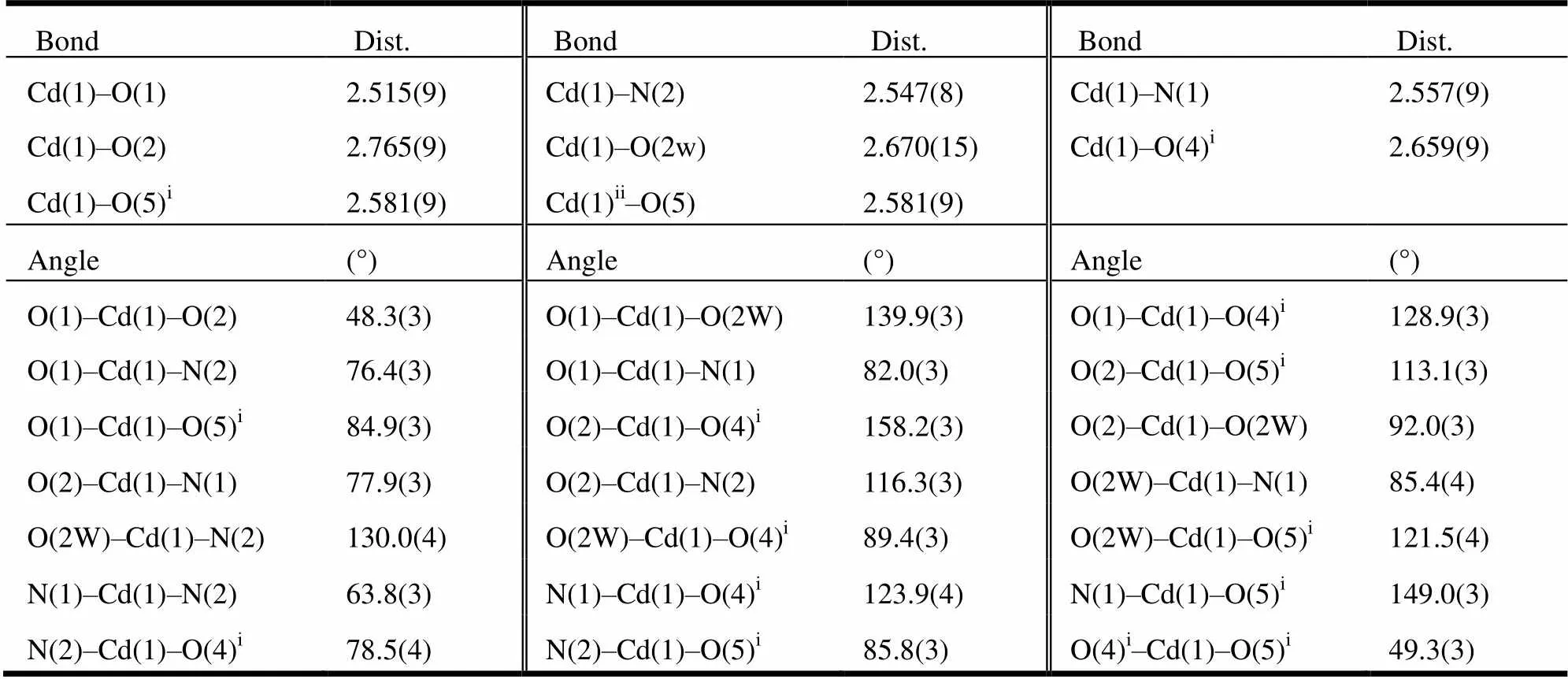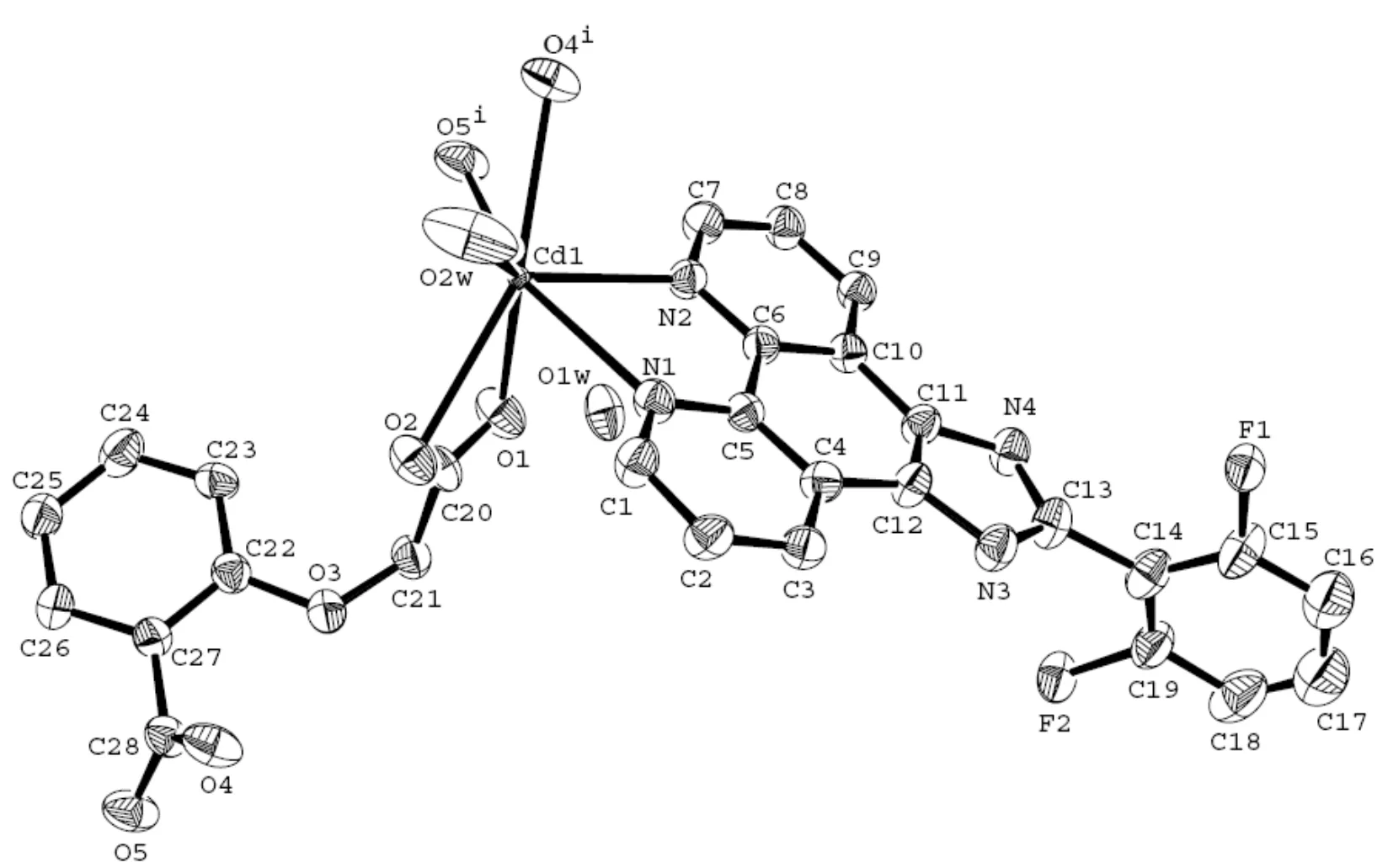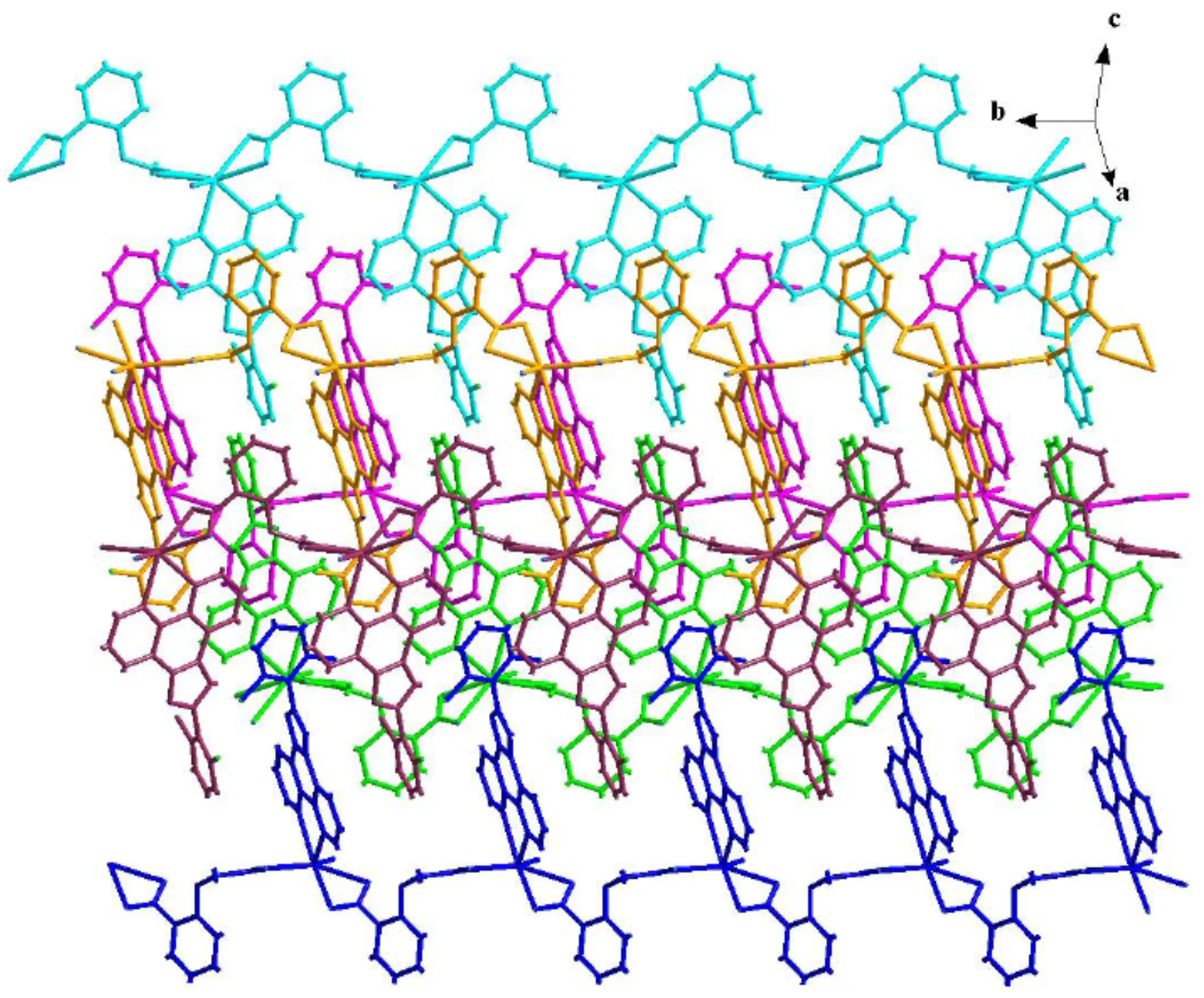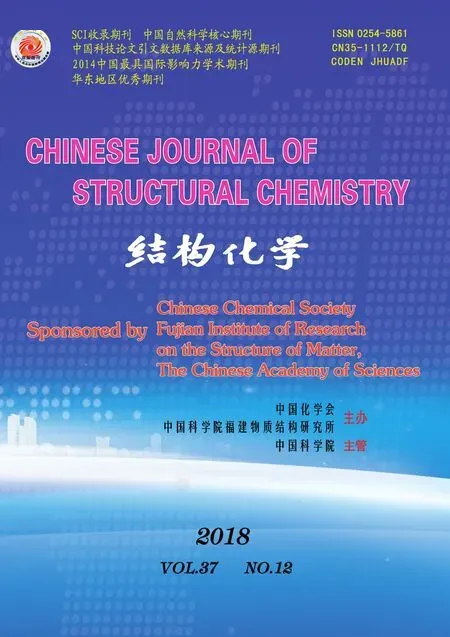A New Luminescent Cd(II) Coordination Polymer Constructed with 2-(Carboxymethoxy)benzoic Acid①
WANG Xiu-Yan LI Guan-Ting SUN Di-Ya ZHANG Ying LIU Dong-Xue XU Zhan-Lin
A New Luminescent Cd(II) Coordination Polymer Constructed with 2-(Carboxymethoxy)benzoic Acid①
WANG Xiu-Yana, bLI Guan-Tinga, bSUN Di-YabZHANG YingbLIU Dong-Xuea, bXU Zhan-Lina, b②
a(()130103)b(136000)
In this work, we synthesized a new Cd(II) coordination polymer, [Cd(L)(cmb)H2O]· H2O (1), by using mixed 2-(carboxymethoxy)benzoic acid (H2cmb)and typical chelating-donor ligands 2-(2-fluoro-6-fluorophenyl)-1-imidazo[4,5-][1,10]phenanthroline ligand (L). 1 crystalli- zes in monoclinic, space group21/with= 17.6150(8),= 9.7811(4),= 18.1603(8) Å,= 118.9150(10)o,= 2738.9(2) Å3,= 4, C28H20CdF2N4O7,M= 674.88,D= 1.637 g/cm3,(000) = 1352,(Mo) = 0.865 mm–1,= 0.0643 and= 0.1976. In 1, the cmb2–anions link neighboring Cd(II) atoms in a bis-chelating mode, yielding a one-dimensional chain structure along theaxis.The L ligands are attached on one side of the chain through chelating the Cd(II) atoms, and are stacked with those of an adjacentchain through-interactions to generate a one-dimensional double-chain structure. Furthermore, the one-dimensional double-chains are stacked by C–H∙∙∙interactions between the carbon atom of L ligand and the benzene ring of cmb2–ligand to give a layer structure. Moreover, the solid state luminescent property of 1 was also investigated at room temperature.
crystal structure, coordination polymer, 2-(carboxymethoxy)benzoic acid;
1 INTRODUCTION
The design and synthesis of coordination poly- mers on the basis of metal ions and multifunctional organic ligands have been rapidly developed in the past decades due to their potential applications as functional materials in proton conduction, sensing, magnetism, luminescence, gas storage and cataly- sis[1-7].Among various organic ligands, polycar- boxylate anions have been well investigated by Yaghi[8].However, the new flexible dicar- boxylate ligand,H2cmb, has received less attention[9, 10].H2cmb contains one flexible heterooxygen atom and one -CH2- spacer at the molecule. So, one carboxy- late can freely twist to meet the requirement of coordination geometry of metal atom in the assembly process. Therefore, the flexible H2cmb is a good candidate for the construction of coordination polymers, particularly in the presence of N-donor chelating ligands. Undeniably speaking,1,10-phen- anthroline (phen) derivatives have been widely used to build coordination polymers owing to their excellent coordinating ability and large conjugated system that can easily forminteractions[11-14]. For example, the phen derivative 2-(2-fluoro-6- fluorophenyl)-1-imidazo[4,5-][1,10]phenanthro-line ligand (L) possesses fruitful aromatic system, and is a good candidate for the construction of coor- dination polymers.
Based on the above consideration, we selected H2cmb as the linker and L as a secondary ligand, generating a new coordination polymer, namely [Cd(L)(cmb)H2O]·H2O, under hydrothermal condi- tions.
2 EXPERIMENTAL
2. 1 Generals
All the materials were of analytical reagent grade and used as received without further purification. Elemental analysis was carried out with a Perkin- Elmer 240C analyzer. The photoluminescent proper- ties were measured on an FLSP920 Edinburgh Fluorescence Spectrometer.
2. 2 Synthesis and crystal growth
1 was synthesized hydrothermally in a 20 mL Teflon-lined autoclave by heating a mixture of H2cmb (0.4 mmol), Cd(NO3)2·4H2O (0.4 mmol) and L (0.4 mmol) in 10 mL of water at 443 K for 6 days under autogenous pressure. The resulting mixture was filtered off after the reaction solution was cooled down gradually. Yellow rectangular crystals were obtained from the reaction system by filtration. The product was collected by filtration, washed with ethanol and dried in air. Crystals of 1 were collected in 35% yield based on cadmium. Anal. Calcd. for C28H20CdF2N4O7(%): C, 49.83; H, 2.99; N, 8.30. Found (%): C, 48.56; H, 2.87; N, 8.11.
2. 3 X-ray structure determination
A single crystal with dimensions of 0.33mm × 0.48mm × 0.32mm was chosen and mounted on a Bruker-AXS Smart CCD diffractometer equipped with a graphite-monochromatized Mo(= 0.71073 Å) radiation by using anscan method at 293(2) K. Out of the 13511 total reflections collec- ted in the 2.24≤≤25.00º range, 4826 were inde- pendent withint= 0.0198, of which 4317 were considered to be observed (> 2()) and used in the succeeding refinement. The structure was solved by direct methods with SHELXS-97 program[15]and refined with SHELXL 97[16]by full-matrix least- squares techniques on2. All H atoms were positioned geometrically (N–H = 0.86 Å and C–H = 0.93 Å) and refined as riding, withiso(H) = 1.2eq(carrier). The water H-atoms of O1W and O2W were not located in a difference Fourier map. The final= 0.0643 and= 0.1976 (= 1/[2(F2) + (0.1345)2+ 11.4309], where= (F2+ 2F2)/3).= 1.093, (Δ)max= 1.104, (Δ)min= –1.124 e/Å3and (Δ/)max= 0.001.
3 RESULTS AND DISCUSSION
3. 1 Description of the crystal structure
The selected bond distances and bond angles are listed in Table 1. The asymmetry unit of 1 contains one center Cd(II) atom, one L ligand, one cmb2–anion, and two water molecules. As shown in Fig. 1, each Cd(II) center is seven-coordinated by two nitrogen atoms from one L ligand, four carboxylate oxygen atoms from two different cmb2–anions and one oxygen atom from a water molecule. The Cd–O distances range from 2.515(9) to 2.765(9) Å, and the Cd–N distances are 2.547(8) and 2.557(9) Å.The bond distances of Cd–O are close to the homologous bond distances of other structural coordination polymer constructed with 2-(carboxymethoxy)ben- zoic acid[9]. As illustrated in Fig. 2, the cmb2–anions link two neighboring Cd(II) atoms in a bis-chelating mode, yielding a one-dimensional chain structure with the Cd···Cd distance of 9.781 Å along theaxis. The L ligands are located on one side of the one-dimensional chain through chelating the Cd(II) atoms. We can see that the N-donor chelating ligand (L) plays an important role in the construction of the one-dimensional double-chain. The large conjugated L ligands are stacked with those of an adjacentchain throughinteractions to generate a one-dimen- sional double-chain structure (C(14)~C(19), N(1)/C(1)~C(5) at (2–, –1/2 +, 1/2–), centroid- to-centroid distance 3.951(9) Å and face-to-face distance 3.466(8) Å, and dihedral angle of 2.6(8)o). Interestingly, the C–H∙∙∙interactions have been found. It is the C–H∙∙∙interactions between the C(18) atom of the L ligand and the benzene ring (C(22)~C(27) at (2–, 1–, 1–)) of cmb2–ligand (3.75(2) Å, and angle of 6.4o) (Fig. 3). When these interactions are taken into account, the one-dimen- sional double-chains become a two-dimensional supramolecular layer (Fig. 3). Additionally, there exists N–H∙∙∙O hydrogen bond (N(4)–H(4) = 0.86, H(4)∙∙∙O(1W)iii= 1.93, N(4)∙∙∙O(1W)iii= 2.771(13) Å,ÐN(4)–H(4)∙∙∙O(1W)iii= 164.8°, symmetric code:iii+2, –, –+1) in 1.

Table 1. Selected Bond Lengths (Å) and Bond Angles (°)
Symmetry transformation:i,–1,;ii,+1,

Fig. 1. View of the coordination environment of 1
Fig. 2. View of the one-dimensional double-chain structure of 1formed byinteractions

Fig. 3. View of the layer structure of 1 formed by C–H∙∙∙interactions
3. 2 Luminescent properties
In this work, the luminescent properties of 1 and L have been studied in the solid state at room temperature (Fig. 4). The emission spectra of H2cmb and L ligands show emissions at 359 (ex= 318 nm)[9]and 407 nm (ex= 325 nm), respectively, which are probably attributable to theor*→transition[17].The emission spectra for 1 exhibit maximum emission peaks at 557 nm (ex= 325 nm). On complexation of H2cmb and L ligand, the emission arising from free H2cmb or L ligand was not observed. Therefore, the emission spectra for 1is neither metal-to-ligand charge transfer (MLCT) nor ligand-to-metal transfer (LMCT) in nature because the Cd(II) ion is difficult to oxidize or reduce due to its10configuration[18].Thus, it may be assigned to intraligand (*→n or*→) emission[19].

Fig. 4. Solid state emission spectra of 1 and L at room temperature
4 CONCLUSION
In summary, we report a new Cd(II) coordination polymer constructed by 2-(carboxymethoxy)benzoic acid (H2cmb) and 1,10-phenanthroline derivative (L). In 1, eachcmb2–anion links neighboring Cd(II) atoms to afford a one-dimensional chain structure. The L ligands are stacked with those of an adjacentchain through-interactions to generateone-dimensional double-chains, which are further joined together by C–H∙∙∙interactions to result in the supramolecular layer.Moreover, 1 shows strong emission in the solid state at room temperature.
(1) Bu, X. H.; Hou, W. F.; Du, M.; Chen, W.; Zhang, R. H. Varying the frameworks of novel silver(I) coordination polymers with thioethers by altering the backbone or terminal groups of ligands.2002, 2, 303–307.
(2) Long, J. R.; Yaghi, O. M. The pervasive chemistry of metal-organic frameworks.2009, 38, 1213–1214.
(3) Kong, Z. G.; Guo, S. N.; Zhao, X. Y.; An, X. An unusual 2D → 3D polythreading framework based on (4)-c sql networks with arms: synthesis, structure and luminescence.2016, 26, 52-53.
(4) Zhou, S.; Lv, C.; Li, J.; Liu, B. Synthesis, crystal structure and properties of a new cadmium compound with (1,1΄-(1,4-butanediyl)bis(imidazole) and-hydroxybenzoic acid.. 2017, 35, 1395–1401.
(5) Yang, J.; Ma, J. F.; Batten, S. R. Polyrotaxane metal-organic frameworks (PMOFs).2012, 48, 7899–7912.
(6) Allmen, K. D.; Grundmann, H.; Linden, A.; Patzke, G. R. Synthesis and characterization of 0D–3D copper-containing tungstobismuthates obtained from the lacunary precursor Na9[B--BiW9O33].2017, 56, 327–335.
(7) Wu, H.; Liu, H. Y.; Liu, Y. Y.; Yang, J.; Liu, B.; Ma, J. F. An unprecedented 2D→3D metal-organic polyrotaxane framework constructed from cadmium and flexible star-like ligand.2011, 47, 1818–1820.
(8) Furukawa, H.; Kim, J.; Ockwig, N. W.; O’Keeffe, M.;Yaghi, O. M. Control of vertex geometry, structure dimensionality, functionality, and pore metrics in the reticular synthesis of crystalline metal-organic frameworks and polyhedra.2008, 130, 11650–11661.
(9) Li, C.; Li, D. S.; Zhao, J.; Mou, Y. Q.; Zou, K.; Xiao, S. Z.; Du, M. Structural diversity and fluorescent properties of Zn(II)/Cd(II) coordination polymers with a versatile tecton 2-(carboxymethoxy)benzoic acid and N-donor co-ligands.2011, 13, 6601–6609.
(10) Chen, Z.; Gao, D. L.; Diao, C. H.; Liu, Y.; Ren, J.; Chen, J.; Zhao, B.; Shi, W.; Cheng, P.Syntheses, structures tuned by 4,4′-bipyridine and magneticproperties of a series of transition metal compounds containing-carboxylphenoxyacetate acid.2012, 12, 1201–1211.
(11) Wang, X. Y.; Zhao, Z. Y.; Han, Q.; Yu, M.; Kong, D. Y. A new zinc(II) supramolecular square: synthesis, crystal structure, thermal behavior and luminescence.. 2015, 80, 1289-1295.
(12) Kong, Z. G.; Guo, S. N.; Miao, J. Q.; An, M. Crystal structure and photoluminescence of a new two-dimensional Cd(II) coordination polymer based on 3-(carboxymethoxy)-2-naphthoic acid.2015, 70b, 605–608.
(13) Kong, Z. G.; Wang, W.; Zhang, S. Q.; Zhao, F. W.; Wang, X. Y. Synthesis, crystal structure, physical properties and theoretical calculations of a new one-dimensional Ni(II) coordination polymer constructed by 1,10-phenanthroline derivative ligand and sulfate.. 2015, 25, 1441–1447.
(14) Kong, Z. G.; Liu, D. X.; Li, R.; Jiang, Y.; Wang, L. j.; Hu, B. A new one-dimensional coordination polymer based on 3,5-dinitrosalicylic acid: synthesis, crystal structure, luminescent property and theoretical calculation.2017, 36, 841–847.
(15) Sheldrick, G. M..University of Göttingen, Germany 1997.
(16) Sheldrick,G.M.. University of Göttingen, Germany1997.
(17) Zhang, S. H.; Feng, C. Microwave-assisted synthesis, crystal structure and fluorescence of novel coordination complexes with Schiff base ligands.2010, 997, 62–66.
(18) Allendorf, M. D.; Bauer, C. A.; Bhaktaa, R. K.; Houka, R. J. T. Luminescent metal-organic frameworks.. 2009, 38, 1330−1352.
(19) Sun, D.; Yan, Z. H.; Liu, M. J; Xie, H. Y; Yuan, S.; Lu, H. F; Feng, S. Y; Sun, D. F. Three- and eight-fold interpenetrated ThSi2metal-organic frameworks fine-tuned by the length of ligand.2012, 12, 2902–2907.
22 May 2018;
29 September 2018 (CCDC 1865809)
the National Natural Science Foundation of China (No. 21607051), Institute Foundation of Siping City (No. 2017057) and the Science and Technology Research Projects of the Education Committee of Jilin Province (No. JJKH20180779KJ)
. Majoring in coordination chemistry. E-mail: xuzljlnu@163.com
10.14102/j.cnki.0254-5861.2011-2079
- 结构化学的其它文章
- Two Cd(II) Coordination Polymers Based on a Flexible Tricarboxylate Ligand: Syntheses, Structures, and Photoluminescence and Catalytic Properties①
- A Selective Luminescent Acetone Sensing Coordination Polymer Constructed from Zinc(II) Ions and Imidazolyl-bearing Ligands①
- Blue-emissions Modulated by Packing Forces in Alkaline-earth Metal Organic Frameworks Based on Thiophene-2,5-dicarboxylic: Structures and Theoretical Calculations①
- Syntheses, Crystal Structures and DNA-binding Properties of Zn(II), Ni(II) and Co(II) Compounds Containing Thiazole Derivatives①
- Synthesis, Single-crystal Structure and Fluorescence Property of a New Boron Compound Based on 2-(2΄-Hydroxyphenyl)-1H-benzimidazole①
- Theoretical Investigations on the Structural and Electronic Properties of WO3Polymorphs①

